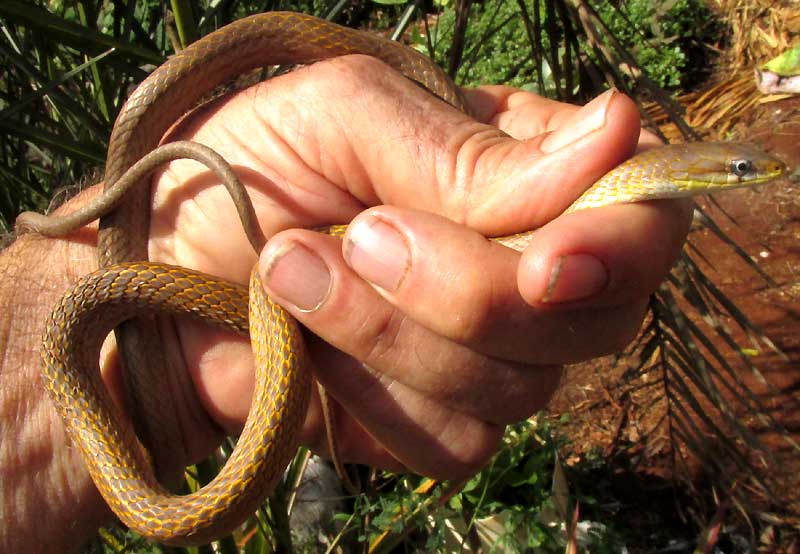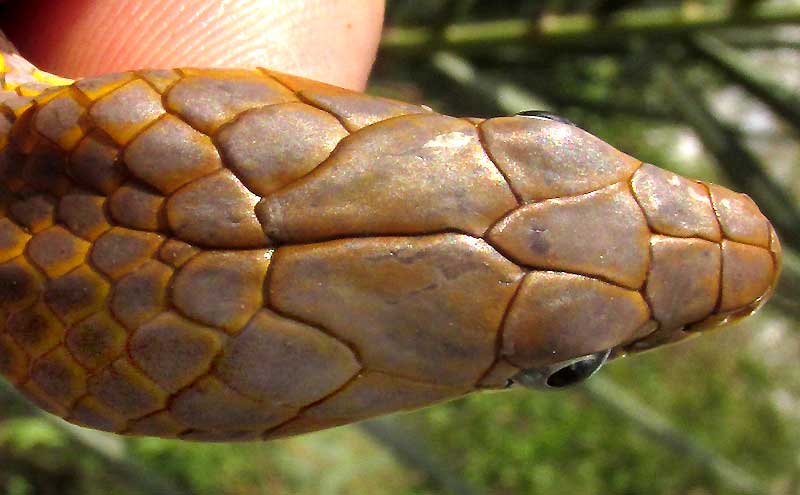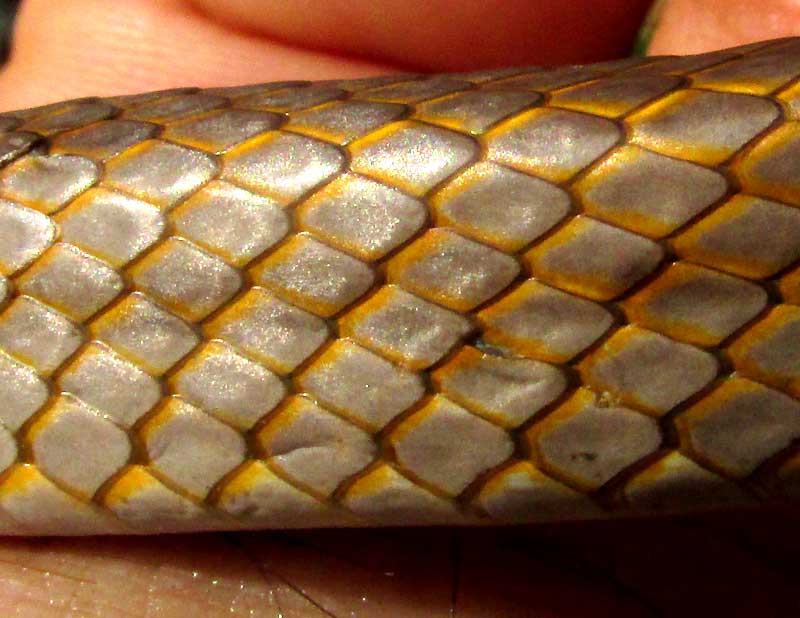Excerpts from Jim Conrad's
Naturalist Newsletter
from the March 8, 2019 Newsletter issued from Rancho Regensis north of Valladolid, Yucatán, MÉXICO;
elevation ~40m (~130 ft), N~20.876°, W~88.170°
YUCATAN WHITE-LIPPED SNAKE

In the rancho's garden this week I was showing around a couple of Swiss visitors when one of them said, "Ach, eine Schlange!"
And it was true: In the crimson center of a pineapple plant's rosette of tough, spiny-edged leaves there lay curled up atop a half-grown pineapple a little snake about two feet long (60cm). Before I could get my camera set up he had slithered from his picturesque podium, but I managed to grab him before he got away, as you can see atop this page.
I wanted to catch him because he didn't look like any snake I'd seen before. This being the case, I made sure to take good close-ups of the snake's scale patterns, because their arrangement is diagnostic in snake identification. The most important are those on the head, whose pattern is clearly revealed below:

You might enjoy comparing the above picture with my general map of snake head scales at www.backyardnature.net/pix/snakscal.jpg
Most importantly, on our garden snake there we see 6 supralabials (scales forming the top lip), 8 infralabials (bottom lip), and 1 loreal (between the scale before the eye and the scale with the nose hole). Scales atop the head are shown below:

A side view showing dorsal scales on one side of the snake is seen below:

In that picture, the scales at the very bottom are broad ventral scales running along the snake's underside, while the dorsals arrange themselves above the ventrals. I count 7 diagonally ascending lines of dorsal scales, and one set of scales running atop the spine, so with two sides that's 7 + 1 +7=15, and that number 15 excludes the vast majority of other species. Also, it's important to notice that the scales are smooth, with no ridge-like "keels" crossing them horizontally, plus a very distinctive feature of these scales is that each is bordered on two sides with golden fringes. Another determinative scale feature is shown below:

In that picture's center, the broadest scale is diagonally broken across it's middle. This is a "divided anal plate," as opposed to the "undivided" kind found in many snake groups. The snake's anus is below this anal plate.
In the end I was glad to have pictures of all these details because they were needed. In Jonathan Campbell's Amphibians and Reptiles of Northern Guatemala, the Yucatán, and Belize, none of the photographs looked exactly like ours. At first I thought we had a Bird-eating Treesnake, but that species' anal scales are undivided. It wasn't a Common Tropical Ratsnake because its labial scales were all wrong. Only with Campbell's technical key could I figure it out, mostly noting scale configuration.
This is SYMPHIMUS MAYAE, which most English-speaking literature seems to called the Yucatan White-lipped Snake, though an important article in the Journal of Zoology calls it the Yucatan Cricket-eating Snake, and in Jonathan Campbell's book it's the Mayan Golden-backed Snake. I'd disqualified Campbell's picture of the species because it showed a snake with distinct dark lines running along its length and the snake's "lips" were pure white, while ours are yellow. Coloration can lie, but not the scale patterns. We simply have a yellow-lipped Yucatan White-lipped Snake.
All the English names include the word Yucatan because the species is endemic only to the Yucatan Peninsula, northern Belize and northern Guatemala. Campbell describes it as little-known, but it's not regarded as endangered.
A special feature of Symphimus mayae is that it feeds almost exclusively on insects in the Order Homoptera, which includes grasshoppers, crickets, mantids, stick insects and katydids. In the garden we have plenty of those, especially because I water it, making it an oasis of greenery during our current dry season when most of the landscape is turning brown and gray.